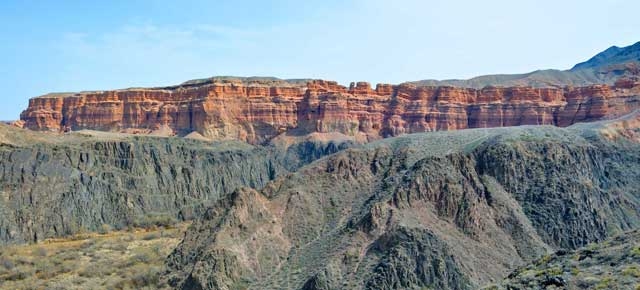Contact
DMT Petrologic GmbH & Co. KG
Karl-Wiechert-Allee 76
30625 Hannover, Germany
Phone: +49 511 5413917
E-Mail: info dmtpetrologic.com
dmtpetrologic.com
Noise Attenuation
Noisy traces or even statistical noise can lead to problems in subsequent processing (e.g. migrations) and have to be removed. Due to different kinds of noise (e.g. random noise, ground roll and other coherent noise), congruous cleaning tools are available in order to attenuate interfering signals and to improve the signal-to-noise-ratio.
Land Processing
FX Swell Noise Attenuation In Different Domains
The term swell noise refers to bursts of low frequency noise recorded in towed streamer acquisition. But the tool can also be used to remove noise bursts from land data. We use a predictive FX-Filter to target this noise in either common shot or common receiver or common offset domain. The filter compares the frequency spectrum of the traces across the gather, if a user defined threshold is exceeded for a frequency band, the data is interpolated using the adjacent traces.
Adaptive Ground-roll Attenuation
We can offer a method to adaptively predict and subtract ground roll from data. The noise model is modelled as a series of dispersive linear events in shot domain which is then adapted to the real data using a least-squares approach. The yielded noise model can be subtracted either directly or by adaptive subtraction from the data. This approach prevents primary energy loss and ensures that no primary data is transformed, smeared or even touched during the denoising. This tool can not only be used for ground attenuation in land setting but also for any linear denoise in other data types (marine, multi component, ...).
Radial Filter
This reversible process transforms a shot from T-X into the radial domain, where a greater separation between data and ground roll exists. Here a frequency filter with the ground-roll frequency range is used on the ground roll affected dips only. As result the ground roll is effectively removed and the primary data is left untouched.
Structure-Oriented Denoise
This tool enhances geological structures very well and tackles mostly very steep dipping noise, without smearing as for FX-Deconvolution- or FK-Power-Filters. The present dips are estimated on stacked sections and all dips which are not encompassed in this dip field are attenuated.
Frequency Balancing
Frequency balancing is performed as time varying spectral normalization which adjusts the amplitudes of each frequency band in a defined range and lead to a distinct improvement in the quality of the stack image.
Noisy Trace Editing
The process is an ensemble tool working on time slices in the CMP/offset- domain after NMO- corrections. Denoising is performed by rejecting traces failing a prescribed number of standard deviations from the computed mean. The process parameters are user dependent and can be applied time-variant whereas contents of traces detected as noisy or spiky are replaced subsequently with good values of neighbouring traces.
Marine Processing
Swell & Wave Noise Attenuation
Swell noise is observed, when currents flow across the streamer and cause turbulences which results in noise being recorded. Noisy traces have a different frequency spectrum compared to normal traces. The filter used to remove swell noise compares the frequency spectrum in frequency bands and time windows within a gather between traces, noisy traces are identified by a median-threshold. Noisy time windows are flagged and interpolated from neighboring traces using a FX interpolator.
Bad Channel Denoise
In order to eliminate traces containing strong noise, a statistical filter based on the RMS amplitude of each trace in relation to the median amplitude is used. Traces with a defined threshold below or higher are removed from the dataset. Removed traces are interpolated after removal from the neighborhood. Normally it is a good idea to preserve Near-Offset traces from editing.
Strum Noise Attenuation
Strum noise means vibrations of the streamer cable which are induced by the Von-Karman vortices detaching when cross flows passes over the streamer cable. Strumming noise contains mostly low frequencies shows up especially at the front and the back of the cable. In order to remove strumming noise a two-pass linear right- and left-dipping tau-p filter can be applied.
Non-Propagating Noise Attenuation
This process tackles events with dips steeper than the water velocity of waves which generally cannot propagate in water. They can be muted out as noise by a FK-Dip-Filter. In order to avoid artefacts the near offsets are extrapolated and traces are padded at the far offsets.
